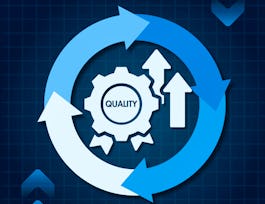This course introduces you to the processes and tools to implement the improvement strategies and then sustain them by controlling your process as per the implemented solutions. Based on the analysis from the previous phases of the define, measure, analyze, improve, and control (DMAIC) framework, you will learn to evaluate the potential solutions and select the most effective ones to bring improvement to your process. This may involve changing the process, introducing new tools or technologies, or implementing best practices. The course also delves into the importance of continuously refining and optimizing the process to maximize the impact of the improvement solutions.



Improvement Techniques and Control Tools
This course is part of ASQ-Certified Six Sigma Yellow Belt Exam Prep Specialization Specialization


Instructors: E R Suresh Narain
Sponsored by BrightStar Care
Recommended experience
What you'll learn
Implement the identified solutions to bring improvement by making process amendments and introducing new tools or technologies.
Optimize the process to maximize the impact of the improvement solutions.
Define and implement control measures to monitor the process and ensure it stays on track.
Implement mechanisms to sustain the improvements over the long term.
Details to know

Add to your LinkedIn profile
11 assignments
See how employees at top companies are mastering in-demand skills

Build your subject-matter expertise
- Learn new concepts from industry experts
- Gain a foundational understanding of a subject or tool
- Develop job-relevant skills with hands-on projects
- Earn a shareable career certificate


Earn a career certificate
Add this credential to your LinkedIn profile, resume, or CV
Share it on social media and in your performance review

There are 5 modules in this course
In this module, you will be introduced to the core principles and methodologies of Lean thinking. You will gain insight into essential Lean tools and techniques such as the five Ss (5S), 5S plus safety, and 6S and single-minute exchange of die (SMED), enabling you to lead process improvement initiatives within your organizations successfully. You will learn to implement SMED, a Lean tool used in manufacturing, to decrease the equipment changeover time. Additionally, you will be introduced to 5S, another Lean tool that represents the steps needed to accomplish this objective, namely, sort, set, shine, standardize, and sustain. The key objective of 5S is to create an uncluttered environment that enables people to carry out their job responsibilities without wasting time and reducing the risk of injury.
What's included
7 videos2 readings3 assignments1 discussion prompt
This module introduces you to another powerful and effective Lean tool, poka-yoke, which was developed as a key component of the Toyota Production System (TPS). Poka-yoke is a process improvement technique, literally meaning “avoiding mistakes or errors.” It was developed in the 1960s by Shigeo Shingo. This technique significantly decreases the number of defects produced and is also known as error-proofing. In this module, you will learn about some real-life examples of poka-yoke and how to implement this technique by eliminating opportunities for defects or errors.
What's included
4 videos1 reading3 assignments1 discussion prompt
In this module, you will learn about the concept of the eight wastes or 8 forms of waste, which is a fundamental Lean manufacturing and Six Sigma principle. The various non-value-added activities and inefficiencies within a process are known as the eight types of waste. Finding and reducing or eliminating these wastes can cut down your organization’s costs, chances of accidents, and lead times and make both employees and end customers happier. Waste reduction is a fundamental concept in Lean Six Sigma, and this module will equip you with the knowledge and tools needed to improve efficiency, productivity, and quality within your process and organization.
What's included
9 videos1 reading3 assignments1 discussion prompt
In this module, you will gain an overview of control charts and their application in process monitoring and quality control. Control charts determine if a process is in control or is stable or if it is out of control and requires some adjustment. Control charts are beneficial for your organization as you need to take some action to correct the variations that could have a negative impact on your business. You will learn about specific control charts for continuous data and how to create and interpret these charts, analyze patterns, and make data-driven decisions to improve process stability and performance. The module combines theoretical knowledge with practical exercises and case studies to equip you with the skills to implement control charts in various industries.
What's included
3 videos1 reading2 assignments1 discussion prompt
In this module, you will work on a peer-review assignment, which is based on the concepts taught in the Improvement Techniques and Control Tools course. In this assignment, you will apply your knowledge about Poka-Yoke to identify how various Poka-Yoke techniques are used in real life. This will encourage you to look around and study from examples in everyday life.
What's included
1 video2 readings1 peer review
Instructors


Offered by
Why people choose Coursera for their career




Recommended if you're interested in Data Science

Kennesaw State University

Board Infinity

SkillUp EdTech

McMaster University

Open new doors with Coursera Plus
Unlimited access to 10,000+ world-class courses, hands-on projects, and job-ready certificate programs - all included in your subscription
Advance your career with an online degree
Earn a degree from world-class universities - 100% online
Join over 3,400 global companies that choose Coursera for Business
Upskill your employees to excel in the digital economy


